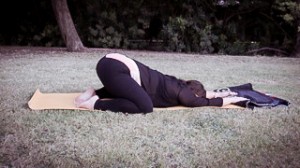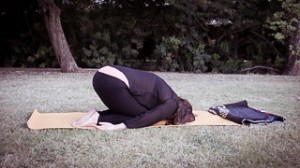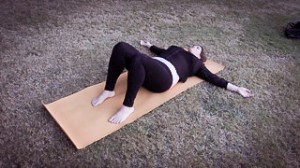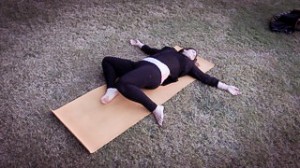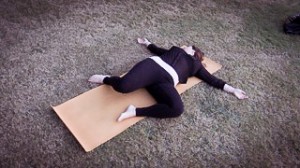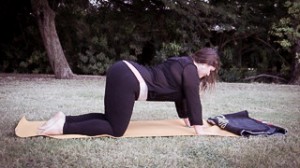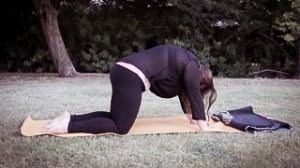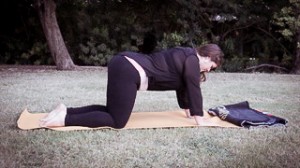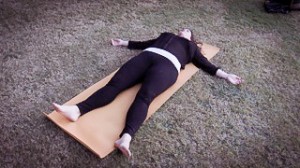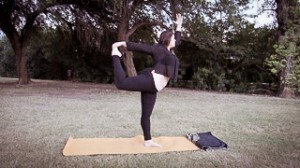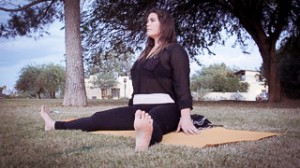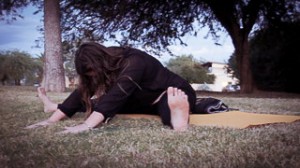Now, I must confess, I have not done yoga before and have very little experience with it. But, when today’s guest blogger, Bethanie Wright, offered to do an article on yoga for PCOS, I was intrigued. I’m always interested in finding out about things that can help my PCOS.
Bethanie is has a Bachelors Degree in Psychology and was diagnosed with PCOS in 2013. She practices yoga regularly and believes that yoga, along with diet and exercise, has been an integral part of her healing and dealing with PCOS.
So, I’m going to hand you over to Bethanie to look at how yoga can help us with our PCOS. As with any PCOS management strategies, please consult your doctor if you have any questions or before starting any new treatment regime.
Recently, yoga has been creeping out from under the woodwork and becoming something that is relatively well-known, at least here in the United States, where I take residence. It’s even become quite trendy with new yoga magazines, new yoga clothing stores, new yoga studios and new yoga props popping up everywhere it seems. As a yoga instructor, some places, I personally feel, have even skewed yoga’s true meaning and purpose combining it with Pilates (not that there is anything wrong with Pilates, just the combination isn’t the best idea), turning it into a lean, mean, fat-fighting machine, catering to very specific clientele and people may be feeling they have to look or be a certain way to jump on the yoga bandwagon. This is untrue. One of the most beautiful things about yoga is you can be who you are, how you are, anywhere you are, believe anything you believe and yoga is still for you. Anyone can do yoga! Even our beautiful, voluptuous, PCOS selves. Actually, yoga is an amazing complementary practice alongside our PCOS diet and exercise and can have some profound changes, even molecularly. Interesting, huh. We are what we…think, too!

As we are very well-aware, we tend to struggle with mood instability, weight gain, irregular moon cycles (periods), intense carbohydrate cravings and of course a whole slew of additional symptoms that make it a difficult process to overcome. Tarryn has already taught us a great deal on the mechanisms behind our seemingly unruly symptoms but most of our symptoms can be tacked to the increase of testosterone, regardless of the reason, that leads to the cascading effects that we experience. Believe it or not, our periods are programmed to coincide with the cycles of the moon and due to this excess testosterone, our periods are not cycling how they are naturally programmed. Yoga comes in and by completing the asanas and/or meditations, it has an impeccable ability to calm the mind which in turn calms the body, so you start to see a decrease in stress hormones and a regulation of hormonal balance. There are many articles about this all over the internet! Just take a peek at some of them. You can get a small effect if you do yoga occasionally, which is entirely better than nothing, but you will reap the true benefits if you decide to make more of a more frequent practice of it. That’s up to you to experience though! With the better regulation of our hormones, we will see an easement in our tendency toward rapid weight gain too. All of our symptoms are so intricately intertwined, one thing affecting another in turn affecting another. We are all integrated beings. Yoga also helps you learn how to tune into yourself so you are able to more effectively give it exactly what it needs. Now yoga is not a cure-all thing. With the proper PCOS diet and exercise, yoga can help you feel more at ease and slowly decrease these heinous symptoms that we deal with day in and day out and give a little piece of you back to yourself. Give it a try and you will not regret it! I, of course, always encourage speaking with your doctor before beginning anything new, such as yoga, to ensure you do what is truly best for yourself and your unique body.
Here are a few poses to try that are good for us women with PCOS:
Child’s Pose
Start on your hands and knees and pressing through your palms, allow your bottom to move toward your heals curling up into a little ball. Some women, like me, are quite busty so child’s pose tends to be best for these types of figures with big toes touching and knees wide apart allowing the bust to fall between the knees. This positioning is also helpful for those that have larger bellies.
Benefits: Helps release the lower back of tension, relieve menstrual cramps if you have your period, calms the CNS (Central Nervous System)
Energetics: Balancing the Venus Chakra. Is known for reaching the back side of the heart, the dark side where we keep those things we don’t like to address. Shed some light on the back side of our heart by breathing in and directing the breath toward the space on our back where the back of our heart is.
Gentle Twists
There are many different twists and in many positions to do them. You choose whatever you feel is right for you. Starting in a laying position, bend your knees, placing your feet on the Earth parallel to each other and about hip-width apart, allow your arms to come out like wings, as if you were a bird. Inhale then exhale your legs off to the right side allowing them to rest on the Earth and your head moving in the opposite direction, or the same direction as your knees. If you can’t get your legs to the floor, place a blanket or bolster under your legs so your legs won’t be floating in space. Inhale your legs up to center, then repeat on the other side.
Benefits: Helps stimulate digestion, brings fresh blood flow to the kidneys, pancreas (some of us struggle with the functioning of our pancreas) and liver, gently massages and stimulates the reproductive organs, calms the CNS
Energetics: Balancing the Mars Chakra balancing our passion, our anger and aggression, balancing our Jupiter Chakra allowing more expansion and growth in our lives.
Cat-Cow Pose
You can choose to do this on your hands and knees if they allow or seated/kneeling. Starting in a neutral spine, press through the middle of your shoulder blades allowing the space between them to become larger, dropping and relaxing the neck, tailbone beginning to point downward toward the Earth creating a large “Cat” arch in the spine. Coming back through neutral and swaying the opposite direction, allow your tailbone to begin to point upward toward the sky, allowing your mid-back to arch in the opposite direction, keeping your head in line with your spine, press out through your shoulders and feel the space between your shoulder blades become smaller, creating a large “Cow” arch of the spine. Move through as many of these as you would like. Inhaling on the “Cow” and exhaling on the “Cat”.
Benefits: Creates a lot of movement in the spine, loosens the shoulders and neck (if you relax them during the pose), massages and stimulates the abdomen and the reproductive organs, awakens the CNS
Energetics: Balancing the Venus Chakra known for self-love, increasing our awareness, compassion and self-love, balancing the Mercury Chakra responsible for effective and precise communication.
Corpse Pose
Lay down completely on your back, arms near your sides or outstretched as if you had wings. Relax every part of your body as much as possible and allow your body to melt into the Earth below you. If you have a tight lumbar spine or it’s just uncomfortable, you can place a blanket, bolster or some type of support under your knees to lighten the torque on the lower back. Also, if you tend to have a larger caboose, you may also want to place a large support under your knees.
Benefits: Centers you, relaxes the lumbar spine, allows you to relax your entire body and work on your abdominal breathing, calms the CNS
Energetics: Balancing of all Chakras
Dancer
Stand with your feet parallel in your mountain pose. Keeping both feet on the floor at this point, bear most of your weight over onto the right side of your body, feeling your right foot become heavier and more grounded than the left. Bend at the knee, allowing your foot to bend up toward your bottom. Place arms wherever comfortable. If you’re feeling adventurous, you can reach your right arm and grab hold of your right foot. If you’re feeling daring, press that right foot into that right hand allowing the mid-back to come into an arch and lean forward hinging from the hips. Come back to your mountain pose and repeat on the other side. Remember, lift from the chest and don’t crunch with the lumbar spine.
Benefits: Uplifting and energizing, leg strengthening, back strengthening, stretches the quads, heart opening which represents compassion and self-acceptance
Energetics: Balancing of the Mars and Jupiter Chakras
Wide-legged seated forward fold
Sit on the floor, or propped but a bolster or blanket, allow your legs to press away from one another where your legs become a wide “v” shape. Gently flex your feet keeping knee caps pointed upward, with elongated spine as if someone is using a string to pull your spine upward and out through the top of your head and lean forward between the “v” shape you created. Breathe, hold as long as you wish and come out of it. Repeat as many times as you feel is right for you.
Benefits: Calming to the CNS, stretches the hamstrings and is very comforting, allows for open space for pelvis to be free and not crunched, relieves lower back tension, relieves menstrual cramps
Energetics: Balancing of the Saturn Chakra, allowing for more stability and trust
f you are on your moon cycle, it’s important to continue to keep the flow downward so try your best to not perform any yoga poses where your pelvis is higher than your head. Good examples are avoiding inversions and if you do perform them, you will actually feel that something isn’t quite right. Our body is cleansing itself and getting rid of a build-up of toxins and matter that have accumulated. It’s best to keep the energy flow moving in the direction it’s supposed to; downward.
I hope you enjoyed this and get a great benefit out of yoga, as I do!
Shanti,
Bethanie
So, what do you think? Have you tried yoga to mange your PCOS? I would love to hear from you! Leave me a comment below!
- sustainable pcos weight loss strategies
- Over 5500 women have done it and seen results
- [bonus] combat cravings kit
- [bonus] intermittent fasting for pcos course
- [BONUS] personalised nutrition plan
JOIN OVER 5,500 OTHERS
